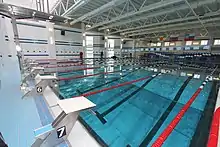Civil Defense Academy of the Ministry of Emergency Situations
The Civil Defence Academy of the Ministry of Emergency Situations of Russia (Russian: Академия гражданской защиты МЧС России; АГЗ МЧС России) is a state institution for the training of highly qualified specialists in the Ministry of Emergency Situations. As part of the Russian Emergencies Ministry, the academy trains troops (both officers and NCOs) for the service of the country's civil defence forces and disaster response services.[1] It was founded in 1992 and is located in Khimki.[2]

History
The Academy was established as the Command Officers' Training and Enhancement Courses of the Air Defence Forces on 25 October 1933 by orders of the People's Commissariat of Defence, the date of which is marked as the anniversary of the formation of the academy. It was reorganized into the Red Army Electrical School in 1935.[3] On 20 January 1949, the Council of Ministers reorganized it into the Republican School for Advanced Training of Officers of the Local Air Defense Units (abbreviated to the MPVO). In 1961, the MPVO was transformed into the Civil Defense of the Soviet Union, with the school being renamed to the Central Courses for Advanced Training of Officers of the Civil Defense. In October 1983, the Presidium of the Supreme Soviet awarded the Order of the Red Star to the course. On 9 December 1992, Prime Minister Yegor Gaidar established the academy in the basis of the Central Command and Control Center and the Civil Defense Courses of the RSFSR. In May 1994, the university received the name Academy of Civil Defence of the EMERCOM of Russia. Since January 2016, it has been a Federal State Budgetary Educational Institution of Higher Education.[4]
Activities

Graduates of the academy have led the national response to civil catastrophes such as the Russian apartment bombings and the collapse of Transvaal Park. They have also provided assistance during natural disasters in Turkey, Colombia, South Ossetia, Afghanistan, Chechnya,[5] Yugoslavia and other countries.
Organization

During its existence, the academy has trained around 6,000 thousand highly specialists. Currently, over 2,500 people study at the academy.[6] The academy includes: two institutes, six faculties, the Cadet Fire and Rescue Corps, twenty-seven departments, seven centers, the training fire and rescue unit, the training and sports complex, the training and experimental complex, the clinic, and the central library of the Ministry of Emergency Situations. The Academy conducts training in postgraduate and postgraduate studies. The Faculty for the Training of Foreign Specialists takes in officers and cadets of from twelve foreign countries: Abkhazia, Armenia, Azerbaijan, Belarus, Kazakhstan, Kyrgyzstan, Moldova, Mongolia, South Ossetia, Tajikistan, Uzbekistan, and Vietnam.
Institutes
- Institute for Special Training
- Institute for the Development of EMERCOM
Faculties
- Faculty of Senior Management
- Cadet Engineering Faculty
- Faculty of Engineering
- Faculty of Humanities
- Faculty of Distance Learning
- Faculty for the Training of Foreign Specialists
Centers
- Research Center
- Educational-Methodical Center
- Center for Teaching Aids
- Logistics Support Center
- Telecommunication center
- Press Service
- Cultural, Leisure and Educational Center
Departments
- Department of Operational Management
- Department of Biomedical and Environmental Protection
- Department of Engineering Protection for the Population
- Department of Tactics and General Military Disciplines
- Department of Rescue Operations
- Department of Radiation and Chemical Protection
- Department of Fire Safety
- Department of Rescue and Robotic Tools
- Department of Information Systems and Technologies
- Department of Information and Communication Technologies and Communication Systems
- Department of Operation of Transport-Technological Machines and Complexes
- Department of Informatics and Computer Engineering
- Department of Air Navigation and Unmanned Aircraft Systems
- Department of Economics, Management and Organization of Public Procurement
- Department of Pedagogy and Psychology
- Department of Legal Disciplines
- Department of State and Municipal Administration
- Department of Philosophy, History and Cultural Studies
- Department of Advertising and Public Relations
- Department of Economic Sustainability and Life Support Systems
- Department of Higher Mathematics
- Department of Foreign Languages
- Department of Mechanics and Engineering Graphics
- Department of Physical Training and Sports
- Department of Physics
- Department of Chemistry and Material Science
- Department of Mobilization Training
Heads
- Lieutenant General Vladilen Sychev (1994 — 2004)
- Lieutenant General Alexander Mezhov (2004 — 12 February 2009)
- Colonel General Sergey Shlyakov (12 February 2009 — December 2012)
- Major General Alexander Mezhov (December 2012 — 22 August 2017)
- Major General Viktor Panchenkov (22 August 2017 — present)
School traditions

The academy maintains a cadet military band, which was founded on 1 September 1999 on the basis of a directive by Minister Sergey Shoygu on 16 July of that year.[7] Cadets of the academy are annual participants in the Moscow Victory Day Parade on Red Square, representing all servicemen of the EMERCOM in a single parade battalion. Originally for the first time since 2002, cadets from the Civil Defense Academy of the Ministry of Emergency Situations were not to take part in the 2018 Moscow Victory Day Parade, while EMERCOM detachments continued to march past in other major parades nationwide, however, the decision was rescinded.[8][9][10][11][12]
See also
External links
References
- "Академия гражданской защиты МЧС России приглашает абитуриентов". www.riakchr.ru.
- "Civil Defense Academy of the Ministry of Emergency Situations (CDA) | Khimki, Russia – Military School Directory". militaryschooldirectory.com.
- https://academygps.ru/obshchie-svedeniya-2/istoriya-akademii-10/
- https://amchs.ru/about_the_university/history/
- статья газеты МО «Красная Звезда» «Есть такая профессия — спасать людей»
- "Академия гражданской защиты МЧС России". xn--b1ae4ad.xn--p1ai.
- https://amchs.ru/about_the_university/struktura/drugie-podrazdeleniya/220/
- Федоров, Константин. "Расчеты МЧС примут участие в параде Победы на Красной площади". m.tvzvezda.ru.
- "Минобороны исключило курсантов МЧС из парада на Красной площади". amp.rbc.ru.
- "Техника, участвующая в параде Победы 9 мая 2018 года". 2 February 2018.
- "Участники парада 9 мая на Красной площади приступили к тренировкам - РИА Новости, 06.02.2018". ria.ru.
- "Росгвардия заменит МЧС в параде 9 мая на Красной площади". 2 February 2018.